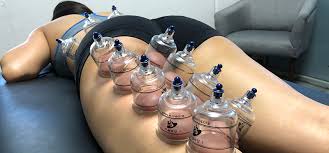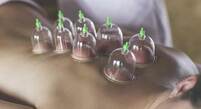Cupping and Gua Sha Therapy

At the 2016 Summer Olympics, Michael Phelps added to the collection of medals that make him "the most decorated Olympian of all time." But the medallions hanging around his neck weren't the only "decorations" that generated attention. The media and public also became fascinated by the tennis ball-sized red circles on his upper back and shoulders. These marks are the result of cupping, a technique dating back to ancient Greece (making it an appropriate topic during the Olympics) that is common practice in traditional Chinese medicine. Cupping involves the use of negative pressure to create a suctioning effect. Recent research published in journals of complementary and alternative medicine report that cupping may be beneficial for low back and neck pain, carpal tunnel syndrome, and knee osteoarthritis amongst other ailments.
We use cupping as a moving massage therapy and to release specific dense tissue in the fascial and muscle systems. Although cupping can leave reddish/purple marks on the skin for a few days, it is often painless and promotes deep relaxation and improved posture and range of motion.
Gua Sha (pronounced 'Gwah Sah') is a technique that involves palpation and cutaneous stimulation where the skin is pressured or scraped in strokes with a round-edged instrument; that results in the appearance of small red petechiae called 'sha', that will fade in 2 to 3 days. Raising Sha promotes normal circulation and metabolic processes. Gua Sha releases fluids that contain metabolic waste and congest the surface tissues and muscles. Gua Sha promotes circulation and normalizes metabolic processes. It is a valuable treatment for both external and internal pain, and facilitates the resolution of both acute and chronic disorders.
We use cupping as a moving massage therapy and to release specific dense tissue in the fascial and muscle systems. Although cupping can leave reddish/purple marks on the skin for a few days, it is often painless and promotes deep relaxation and improved posture and range of motion.
Gua Sha (pronounced 'Gwah Sah') is a technique that involves palpation and cutaneous stimulation where the skin is pressured or scraped in strokes with a round-edged instrument; that results in the appearance of small red petechiae called 'sha', that will fade in 2 to 3 days. Raising Sha promotes normal circulation and metabolic processes. Gua Sha releases fluids that contain metabolic waste and congest the surface tissues and muscles. Gua Sha promotes circulation and normalizes metabolic processes. It is a valuable treatment for both external and internal pain, and facilitates the resolution of both acute and chronic disorders.
